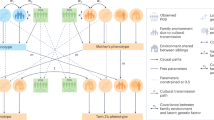Abstract
The twin method is usually credited to Francis Galton's 1875 article on twins. However, Galton did not propose the comparison between identical and fraternal twin resemblance which is the essence of the twin method. Although the twin method was “in the air” in the mid-1920s, the first descriptions of the method appeared in an article by Curtis Merriman and in a book by Hermann Siemens, both in 1924, 50 years after Galton's paper.
Similar content being viewed by others
References
Boring, E. G. (1959). Lewis Madison Terman.Biograph. Mem. 33:414–461.
Burks, B. (1928). The relative influence of nature and nurture upon mental development: A comparative study of foster parent-foster-child resemblance and true parent-true child resemblance.Twenty-Seventh Yearbook of the National Society for the Study of Education, Part 1, pp. 219–316.
Dahlberg, G. (1926).Twin Births and Twins from a Hereditary Point of View, Tidens Tryckery, Stockholm.
Fischer, R. A. (1919). The genesis of twins.Genetics 4:489–499.
Galton, F. (1869).Hereditary Genius: An Inquiry into Its Laws and Consequences, Macmillan, London.
Galton, F. (1874).English Men of Science: Their Nature and Nurture, Clarke, Doble & Brendon, London.
Galton, F. (1875). The history of twins, as a criterion of the relative powers of nature and nurture.Fraser's Mag. Nov. 566–576.
Galton, F. (1876). The history of twins, as a criterion of the relative powers of nature and nurture.J. Anthropol. Inst. 5:391–406.
Galton, F. (1908).Memories of My Life, Methuen, London.
Hirsch, N. D. M. (1930).Twins: Heredity and Environment, Harvard University Press, Cambridge, MA.
Holzinger, K. J. (1929). The relative effects of nature and nurture influences on twin differences.J. Educ. Psychol. 20:141–148.
Lauterbach, C. E. (1925). Studies in twin resemblance.Genetics 10:525–568.
Lowe, S. (1972).Curtis Merriman: An Interview, Unpublished document, University Archives oral history project, University of Wisconsin, Madison.
Merriman, C. (1922).The Intellectual Resemblance of Twins, Unpublished doctoral dissertation, Stanford University, Palo Alto.
Merriman, C. (1924). The intellectual resemblance of twins.Psychol. Monogr. 33:1–58.
Pearson, K. (1924).The Life, Letters, and Labours of Francis Galton, Vol. 2. Cambridge University Press, Cambridge.
Siemens, H. (1924).Die Zwillingspathologie, Springer-Verlag, Berlin.
Stern, C. (1962). Wilhelm Weinberg (1862–1937).Genetics 17:1–5.
Tallman, G. G. (1928). A comparative study of identical and nonidentical twins with respect to intelligence resemblances,Twenty-Seventh Yearbook of the National Society for Studies in Education, pp. 83–86.
Terman, L. M. (1916).The Measurement of Intelligence, Houghton Mifflin, Boston.
Terman, L. M. (1917). The intelligence quotient of Francis Galton in childhood.Am. J. Psychol. 28:208–215.
Terman, L. M. (1928). Introduction.Twenty-Seventh Yearbook of the National Society for the Study of Education, Part 1, pp. 1–7.
Thorndike, E. L. (1905). Measurement of twins.Arch. Philos. Psychol. Sci. Meth. 1:1–64.
von Bracken, H. (1969). Humangenetische Psychologie. In Becker, P. E. (ed.),Humangenetik: ein kurzes Handbuch in funf banden, Band I/II, pp. 409–561.
Wingfield, A. H. (1928).Twins and Orphans: The Inheritance of Intelligence, Dent, London.
Author information
Authors and Affiliations
Additional information
Preparation of this article was supported in part by grants from the National Institute of Child Health and Human Development (HD-10333 and HD-18426), the National Science Foundation (BSN-8806589), and the Successful Aging program of the John D. and Catherine T. MacArthur Foundation.
Rights and permissions
About this article
Cite this article
Rende, R.D., Plomin, R. & Vandenberg, S.G. Who discovered the twin method?. Behav Genet 20, 277–285 (1990). https://doi.org/10.1007/BF01067795
Received:
Accepted:
Issue Date:
DOI: https://doi.org/10.1007/BF01067795




